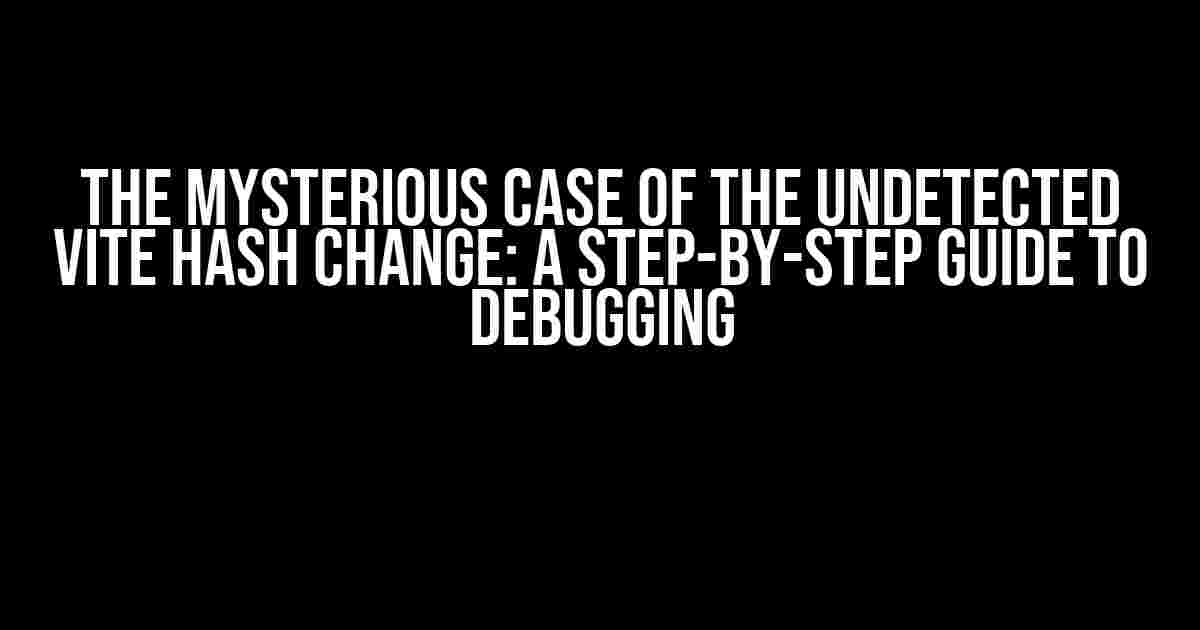Have you ever experienced the frustration of your browser not detecting Vite hash changes after a rebuild and reopen? You’re not alone! This pesky issue has plagued many a developer, leaving them scratching their heads and wondering what went wrong. Fear not, dear reader, for we’re about to embark on a journey to unravel the mystery and get your browser detecting those hash changes in no time!
Understanding Vite and Hash Changes
Before we dive into the solution, it’s essential to understand what Vite and hash changes are all about. Vite is a modern development server that provides an alternative to traditional Webpack-based development workflows. It’s designed to be fast, efficient, and easy to use. One of its key features is the ability to generate a unique hash for each build, which helps browsers detect changes and refresh the page accordingly.
When you make changes to your code and rebuild your project, Vite generates a new hash. This hash is used to identify the updated version of your application. The browser, in turn, uses this hash to determine whether it needs to reload the page or not. Sounds simple, right? Well, sometimes things don’t go as planned, and that’s where our problem arises.
The Symptoms: Browser Fails to Detect Hash Change
So, what does it look like when your browser fails to detect the Vite hash change? You might experience one or more of the following symptoms:
- Your browser doesn’t reload the page after a rebuild, even though you’ve made changes to your code.
- The browser displays an outdated version of your application, ignoring the latest changes.
- You’ve tried clearing the browser cache, but the issue persists.
- You’ve checked the Vite console, and it shows a new hash being generated, but the browser just doesn’t seem to care.
If you’re experiencing any of these symptoms, don’t worry – we’re about to tackle the root causes and provide a solution that’ll get your browser detecting those hash changes in no time!
Cause 1: Inconsistent Hash Generation
Vite relies on a few factors to generate a unique hash for each build. If any of these factors are inconsistent, it can lead to the browser not detecting the hash change. Let’s explore some common culprits:
- Plugin Order: If you’re using plugins like `vite-plugin-xxx`, make sure they’re in the correct order. The order can affect how Vite generates the hash. Try rearranging the plugins to see if it makes a difference.
- Plugin Configuration: Double-check your plugin configurations, as incorrect settings can lead to inconsistent hash generation. Review your `vite.config.js` file and ensure everything is correctly configured.
- File System Changes: If you’re making changes to your file system (e.g., adding or removing files), it can affect the hash generation. Try rebuilding your project after making file system changes to ensure the hash is regenerated correctly.
Cause 2: Browser Cache Interference
Browser cache can be both a blessing and a curse. While it helps improve performance, it can also interfere with Vite’s hash detection. Here are some potential culprits:
- Cache-Control Headers: Check your server configuration to ensure the Cache-Control headers are set correctly. You can use tools like Chrome DevTools to inspect the headers and verify their correctness.
- Browser Extensions: Some browser extensions, like ad blockers or caching plugins, can interfere with Vite’s hash detection. Try disabling these extensions to see if the issue resolves.
- Local Storage and Cookies: Sometimes, local storage and cookies can affect the browser’s ability to detect hash changes. Try clearing local storage and cookies to see if the issue resolves.
The Solution: A Step-by-Step Guide
Now that we’ve explored the common causes, it’s time to provide a step-by-step guide to resolving the issue. Follow these instructions carefully to get your browser detecting those hash changes:
- Verify Vite Configuration: Double-check your `vite.config.js` file to ensure everything is correctly configured. Pay attention to plugin order, configuration, and file system changes.
- Clear Browser Cache: Clear your browser cache, local storage, and cookies to ensure a clean slate. You can do this using Chrome DevTools or by manually clearing the cache.
- Disable Browser Extensions: Disable any browser extensions that might be interfering with Vite’s hash detection.
- Inspect Cache-Control Headers: Use Chrome DevTools to inspect the Cache-Control headers and verify their correctness. If necessary, adjust your server configuration to ensure correct header settings.
- Rebuild and Reopen: Rebuild your project and reopen the browser to see if the issue resolves. If not, proceed to the next step.
- Check Vite Console Output: Check the Vite console output to verify that a new hash is being generated. If not, review your Vite configuration and plugin settings.
- Verify Hash Change: Verify that the hash change is reflected in the browser by checking the page source or using Chrome DevTools.
Additional Troubleshooting Tips
If the above steps don’t resolve the issue, here are some additional troubleshooting tips to help you debug:
- Check the Vite Version: Ensure you’re running the latest version of Vite. Sometimes, older versions can cause issues with hash detection.
- Review Plugin Documentation: Check the documentation for any plugins you’re using to see if they have specific configuration requirements or known issues with hash detection.
- Compare Hashes: Compare the hashes generated by Vite before and after the rebuild to ensure they’re different. You can do this by checking the Vite console output or using a tool like `vite-hash-check`.
- Check for Plugin Conflicts: If you’re using multiple plugins, try disabling them one by one to see if the issue resolves. This can help you identify any plugin conflicts that might be causing the issue.
Conclusion
The mysterious case of the undetected Vite hash change has been solved! By following the steps outlined in this article, you should be able to identify and resolve the root cause of the issue. Remember to stay vigilant and keep an eye out for any changes that might affect hash detection. With Vite and hash changes working harmoniously, you can focus on what matters most – building an amazing application!
| Tip | Description |
|---|---|
| Verify Vite Configuration | Double-check your `vite.config.js` file to ensure everything is correctly configured. |
| Clear Browser Cache | Clear your browser cache, local storage, and cookies to ensure a clean slate. |
| Disable Browser Extensions | Disable any browser extensions that might be interfering with Vite’s hash detection. |
// Example vite.config.js file
import { defineConfig } from 'vite';
import vuePlugin from '@vitejs/plugin-vue';
export default defineConfig({
plugins: [vuePlugin()],
build: {
// Ensure correct plugin order
pluginsOrder: ['vuePlugin'],
},
});
By following the guidelines and troubleshooting tips outlined in this article, you’ll be well-equipped to tackle the pesky issue of Vite hash changes not being detected by your browser. Happy debugging!
Frequently Asked Question
The browser not detecting Vite hash change after rebuild and browser reopen – it’s a common conundrum that has left many developers scratching their heads! Fear not, dear devs, for we’ve got the answers to your burning questions.
Why does my browser not detect Vite hash change after rebuild and browser reopen?
This issue typically occurs when Vite’s development server is not properly configured to handle hash changes. Ensure that you have enabled the `build.hash` option in your `vite.config.js` file. Additionally, check that your browser is not caching outdated build artifacts by clearing the browser cache or using the ” PRIVATE mode” or “incognito mode” in your browser.
How do I configure Vite to handle hash changes correctly?
In your `vite.config.js` file, add the following configuration: `build: { hash: { enabled: true } }`. This enables Vite’s built-in hash generation for your build output. You can also customize the hash generation strategy by providing a custom `hash` function.
What are some common pitfalls to avoid when dealing with Vite hash changes?
Be mindful of the following: not enabling `build.hash` in your Vite config, not using the `vite build` command with the `–watch` flag, and not properly cleaning up old build artifacts. Additionally, ensure that your browser cache is not interfering with your dev workflow.
Can I use other dev servers with Vite to detect hash changes?
Yes, you can use other dev servers like Webpack Dev Server or Rollup Dev Server with Vite. However, ensure that these servers are properly configured to handle hash changes and that you’re not mixing different server configurations, which can lead to conflicts.
How do I troubleshoot Vite hash change issues in my browser?
To troubleshoot, try the following: check your browser’s dev tools for any errors, verify that your Vite config is correct, and clear your browser cache. If the issue persists, try restarting your Vite dev server or seeking help from the Vite community.
Hope this helps you resolve the browser-Vite hash change conundrum!



